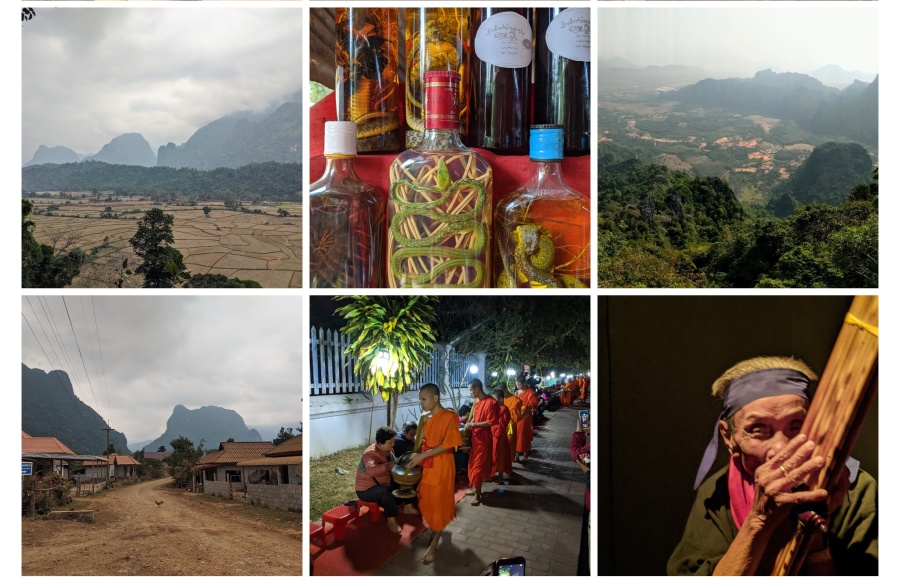
Two Weeks in Laos
Modern-day Laos traces its roots to the ancient Lao kingdom of Lan Xang, which was around from the 14th Century to the late 18th. The kingdom then broke up into three (Luang Prabang, Vientiane, and Champasak). In 1893, these were united again as a French protectorate; Laos finally gained independence in 1953 as a constitutional monarchy. “Shortly after independence, a long civil war began, which saw the communist resistance, supported by the Soviet Union, fight against, first, the monarchy and then a number of military dictatorships, supported by the United States.” The communists won.
Today, Laos is still officially a one-party socialist republic, though a gradual and limited return to private enterprise began in 1988, and has continued. The economy is now growing rapidly, and on the ground one would not conclude that it is governed by Marxism-Leninism.
Laos Today
- GDP per capita is $8,458 (PPP) - 118th in the world - growing at 6.9%
- Human Development Index (HDI) is 0.604 - “medium” - 140th in the world
- 65% buddhist
Sources: Wikipedia and CIA World Factbook
In addition to the Lao flag, all government buildings also sport the red hammer and sickle flag.
As in Cambodia, the US dollar is a de facto secondary currency here, though people here generally have a strong preference for the Lao Kip, where in Cambodia people preferred the dollar. I get charged a fee every time I take out cash, so I try to take out all I might need at a single time. When I took out about $200 USD, I got about 1,700,000 Lao Kip - a stack about an inch thick. When I paid cash for my first hotel, the guy at the front desk put the cash in his own wallet, which was about six inches thick - no joke. I told him that he looks like a rich man, and he laughed.
Luang Prabang
There are many monasteries in Luang Prabang, and each morning before Dawn, hundreds of monks pour out of them and into the streets to get alms for their only meal of the day.
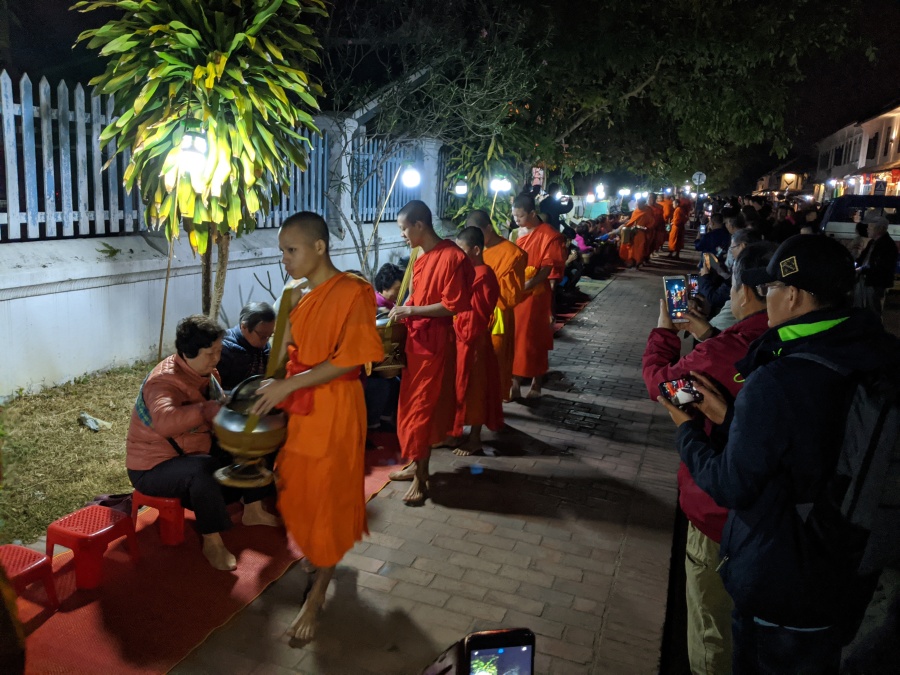
The ceremony has a strange air now, though: it’s been overrun by tourists. Vendors set up sticky rice you can buy and plastic stools to sit on. Some tourists are ok, but others (and it seems to me that they are mostly the Chinese tourists) continue to talk very loudly among themselves through the process. So the monks just walk by with their bowls open and stop in front of these people, who give them rice, but the two groups don’t make eye contact or otherwise acknowledge each other. The whole process felt corrupted to me, in a way.
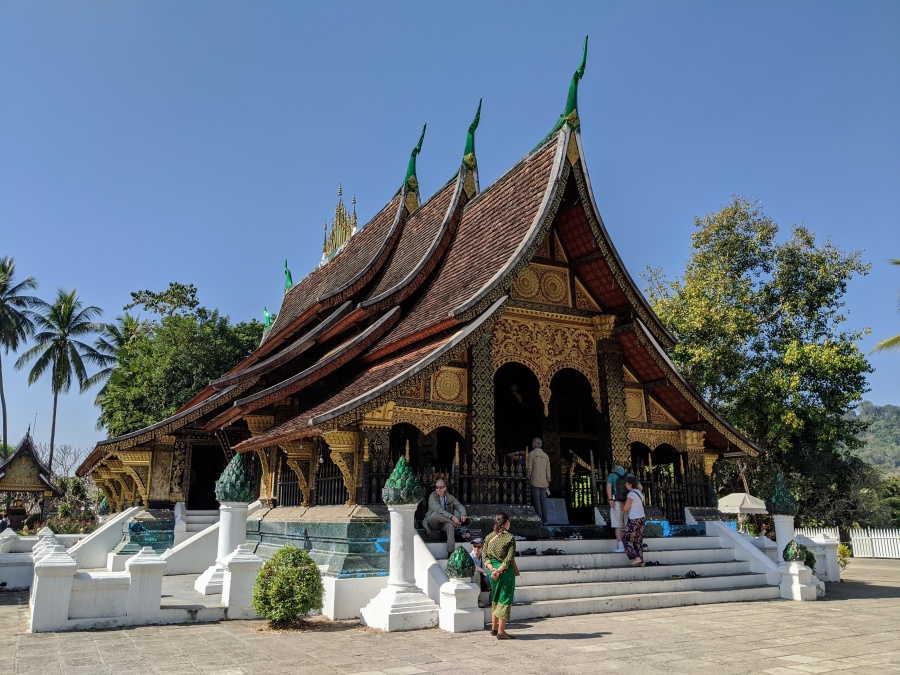
In Luang Prabang, one of the employees of the hotel I stayed at is Chanxai. Chanxai lives in the hotel. When there are empty rooms, he stays in one of them. When there aren’t any empty rooms… he sleeps on the couch in the lobby:
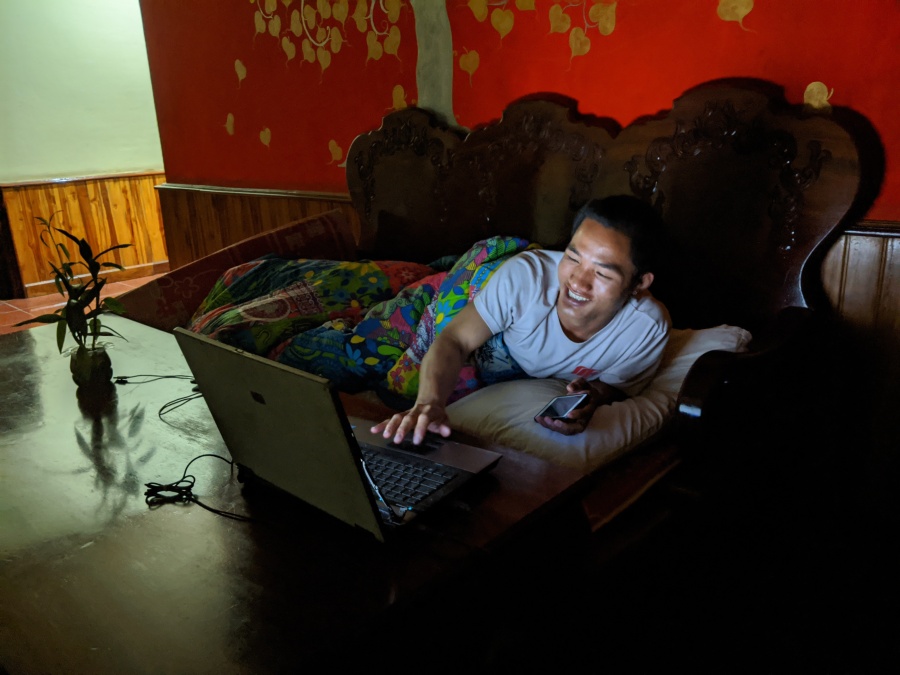
Chanxai was a monk for about three years at age 16-18. After that, though, he wanted to go to China to study, and he applied for a Chinese government scholarship. To be able to go, he had to give up the robes. Chanxai says that his ability to write Chinese wasn’t good enough, though, so he ultimately didn’t get the scholarship - but he did not go back to being a monk. I asked him if he still meditates - he doesn’t. He says sometimes he goes to temples to visit old friends.
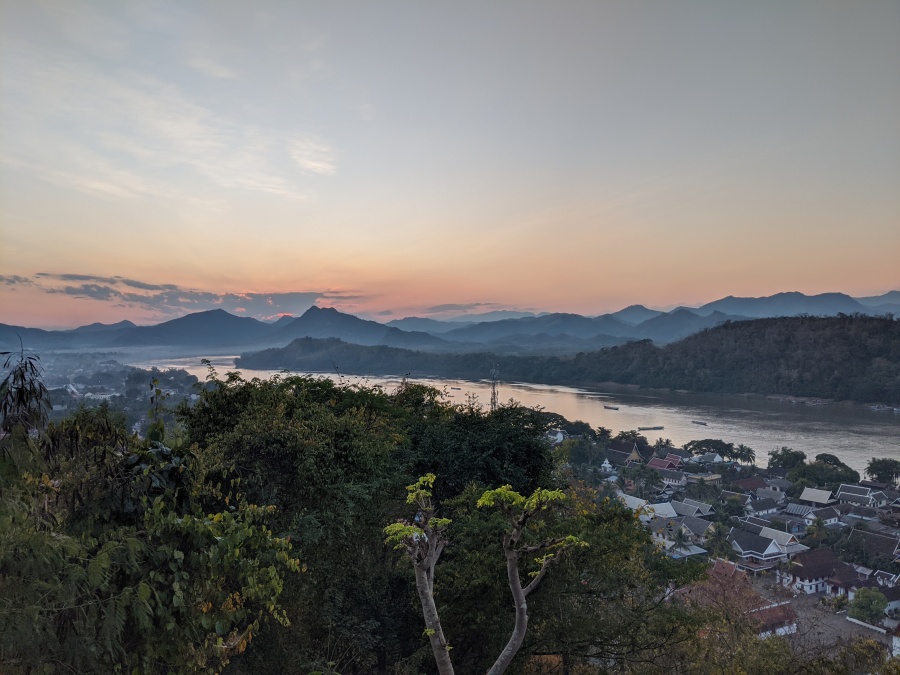
The entire valley seems to be permanently covered by a blanket of thin, gray smoke. This seems to be the case elsewhere in Laos, too - I saw the same in the small mountain town of Vang Vieng, as well as in Vientiane, the capital. Other travelers told me that the mountains of northern Thailand look the same. Why is that? Surely it’s not just the ever-present trash burning?
One of the highlights of the area is Kuang Si waterfall. You can either get a Tuk Tuk, or rent a scooter to get there - both are very cheap.

Pro Tip: don’t stop at the bottom of the waterfall. Climb to the top, and then take the 3km trail to the “cave and spring”. Both are worth visiting, and (unlike the waterfall), few people go there.
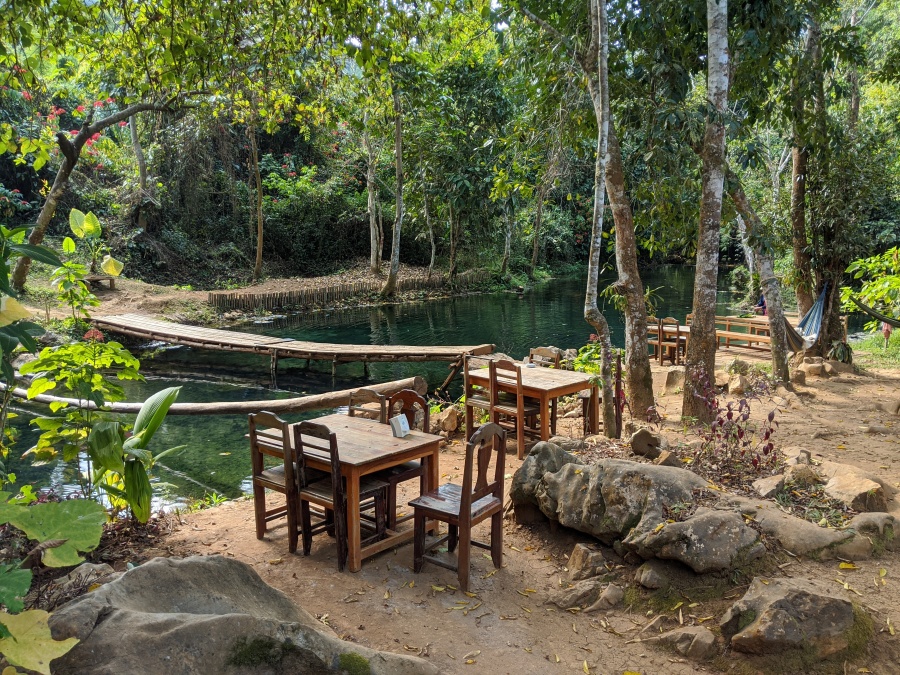
There’s also a restaurant where you can grab some food or a beer. Also there’s a campground there, which looks like a great place to camp. Here it is on Google Maps.
A couple of hours north of Luang Prabang are Pak Ou Caves, which contain hundreds of buddha statues, most of them very small. The best way to get there is via boat ride up the Mekong River. The caves are OK; I think the boat ride is more interesting - watching life unfold along the banks of the river.
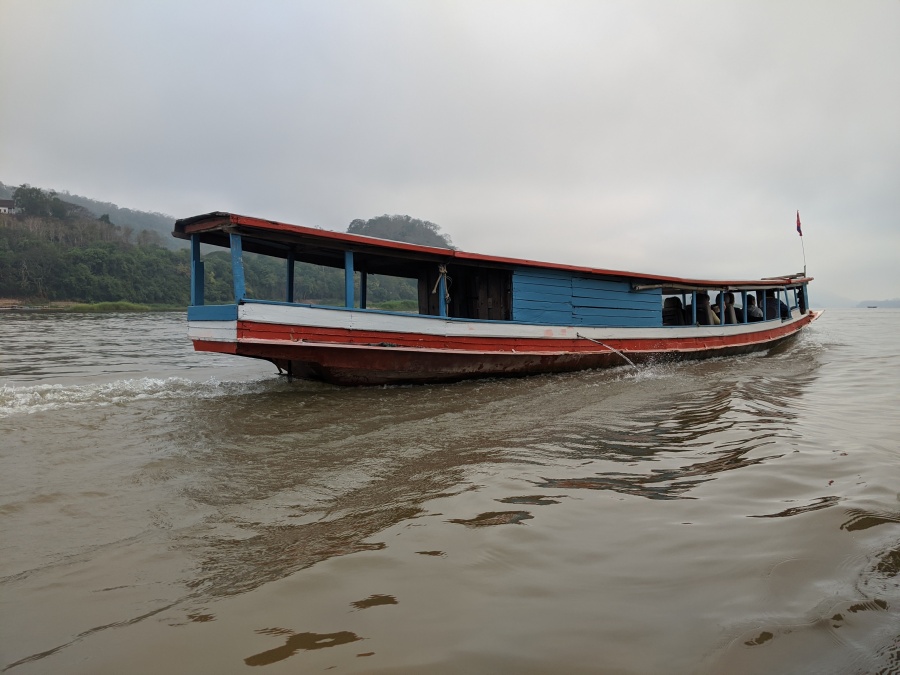
Vang Vieng
Vang Vieng is a small mountain town in central Laos with a colorful history.
The town became really popular with tourists, especially young backpackers. The most popular activity was “tubing” - going down the river in an inflatable inner tube. Along the river are bars with ample cheap booze, and reportedly also drugs for purchase. The bars had swings and slides, all going into a shallow river. Corrupt cops would shakedown hapless tourists, and enough palms were greased that the government was willing to look the other way for a long time. My friend Gregg called it “Amsterdam meets Vietnam 100 years ago”. For more info on this, check out this 2012 article in The Guardian.
Eventually, though, things got out of hand. In 2011, at least 27 people died on the river due to drowning or hitting the rocks, with some people saying the real number is higher. The Lao government cracked down and closed all the bars in 2012. Some new ones have since reopened, but everything is far tamer now - the wild days are past.
Nowadays, more people go to Vang Vieng for the natural beauty - the karst hills surrounding the town. Common activities are trekking, biking, caving, kayaking, rock climbing, driving off-road buggies… and yes, tubing.
My biggest adventure in Vang Vieng, though, was something completely different: I spent half a day MacGuyvering myself out of a locked bathroom… you can read more about that here.
I spent a nice day hiking up the sheer mountain to the Pha Ngern viewpoint. To get to the trailhead, I shunned the main road as much as possible. I crossed the river via a small bamboo bridge, and walked through local farms to get there - an experience unto itself.
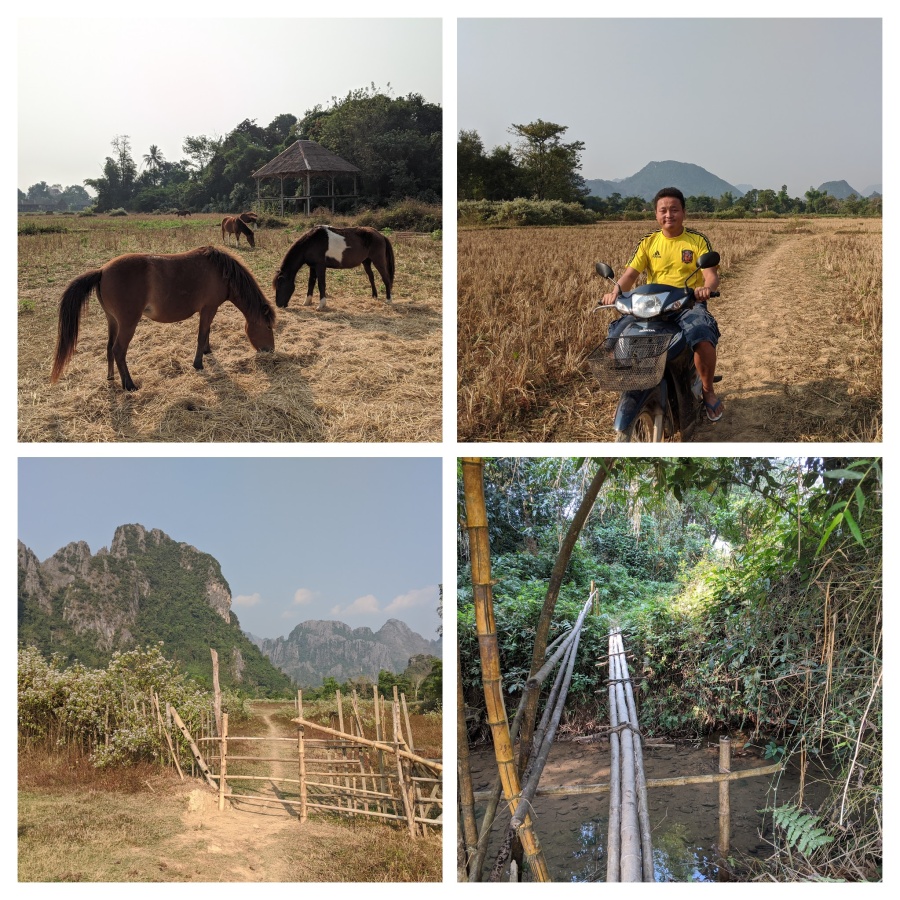
After a couple hours of scrambling up the steep trail, I reached the top:
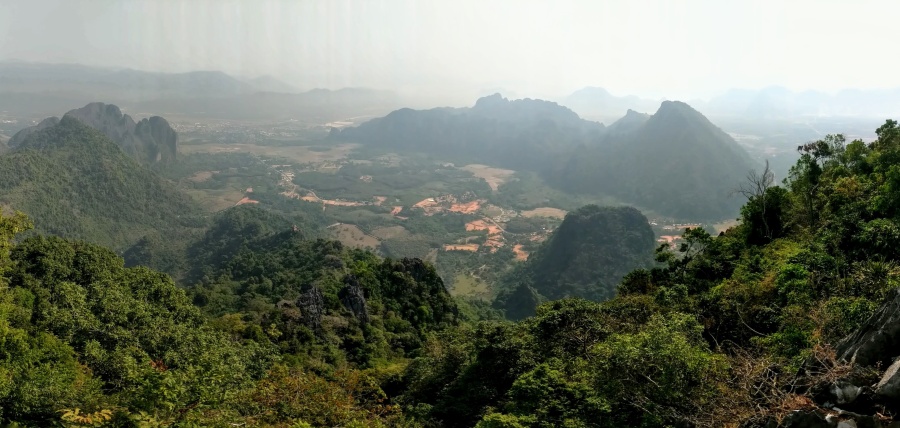
I ate my lunch here. I think that’s one of life’s great simple pleasures: a well-earned sandwich with a stellar view. It tastes a million times better at the top of a mountain than it would at the sandwich shop where it was purchased, while the view and peace offer a prime opportunity to contemplate life, the universe, and everything. When the mountains call… answer!
Other fun activities for me included kayaking down the river, and exploring the Water Cave. There’s a small river running through the Water Cave, with between one and two meters of space between the surface of the water and the ceiling of the cave. They have ropes setup along the ceiling, and you can pull yourself through the cave on an innertube. It’s a cool experience.
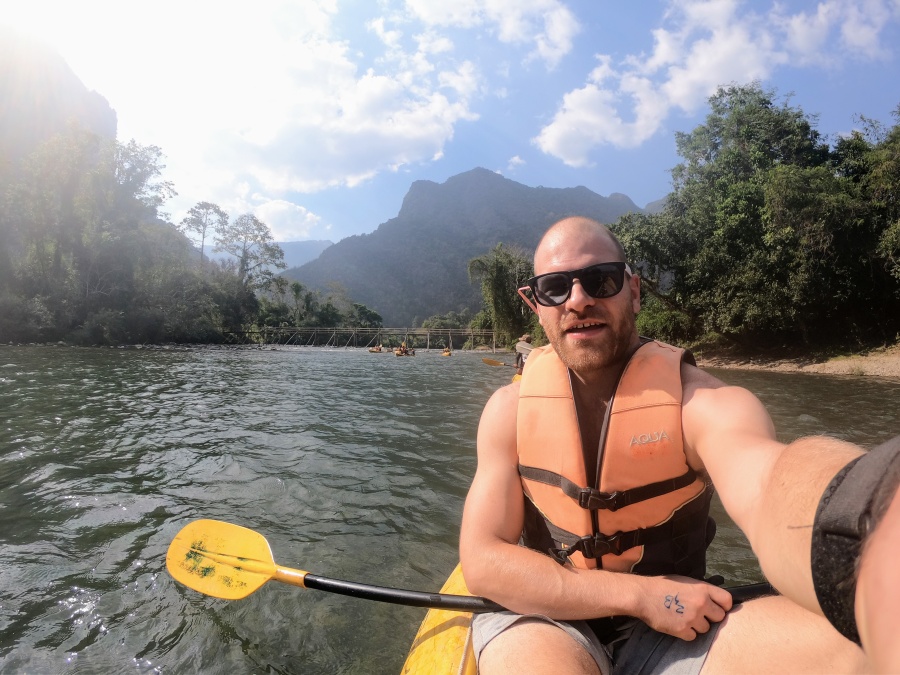
I also spend a day mountain biking around the backroads of the countryside around Vang Vieng. The roads and the bike were both in terrible shape, and I was sore for days afterwards, but I got some great views out of it:

There’s lots of Koreans in Vang Vieng - far more than I’ve seen anywhere else on my travels thus far. They are easily the most numerous tourist groups in town. Indeed, wikipedia cites a Bangkok Post article that claims that since the government crackdown in Vang Vieng, the number of western tourists has declined, while the number of visitors from Japan, China, and South Korea has risen.
Vientiane
Vientiane is the capital of Laos. Some 820,000 people live there, but it feels much smaller than that. The biggest attractions in the area are the many temples here… just like in the rest of Laos, I suppose.
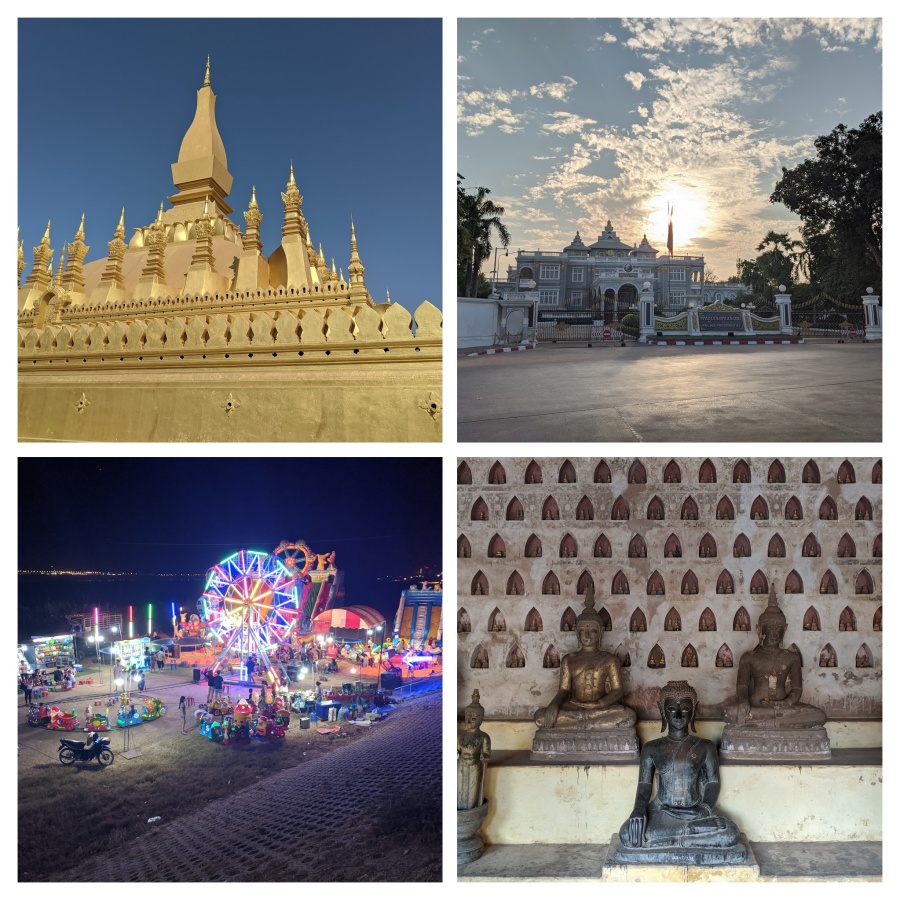
In a crowded cafe on New Year’s Day in central Vientiane, there were no empty tables, and so I joined Kasia at hers. Kasia quit her job as the manager of a clothing retail store in Poland a few months ago, and bought a flight to Vietnam. In Hanoi she bought a scooter for $500 US, and rode it all over Vietnam for about a month and a half before making her way here to Laos. She says that she is “at an age where she isn’t afraid anymore.” I didn’t ask Kasia’s age; I’m more interested in the attitude, and I don’t think it comes from age, or at least not from age alone. She’s had four flat tires on her scooter and got into an accident that banged up her knees, and doesn’t even particularly love riding a scooter. She says life on the road isn’t always how it looks on Facebook - there are cockroaches, and sometimes the hostels are dirty and you end up sleeping with your clothes on, and the roads are dangerous… but through all this, she sounds happy. Good for you, Kasia.
Miscellaneous
Lao people are more reserved than people in neighboring countries. I am not quite sure why that is, but the impression has been confirmed to me by other travelers. This manifests itself in many ways. Service in restaurants is worse - you are usually not greeted with a smile, and I’ve been pointedly ignored in restaurants when trying to order food - even when waving my arms. I’ve also been told I couldn’t go to a temple because I was wearing shorts, which I suppose I understand. On the bright side, street vendors are far less aggressive in pushing their wares here than in other places.
Laos doesn’t have any of the major ride-sharing companies operating here (likely because of government restrictions), and it shows in the costs of getting around. A tuk tuk ride that would have been a $4 Grab car ride in Singapore is $6 here - even though Singapore’s GDP per capita is about 12x higher than Laos’!
Locals wear soccer jerseys very frequently. And I understand why - they’re light, comfortable, and only cost about $3 here.
And so 2020 is here - Happy New Year everyone! Make 2020 a great one!
Comments